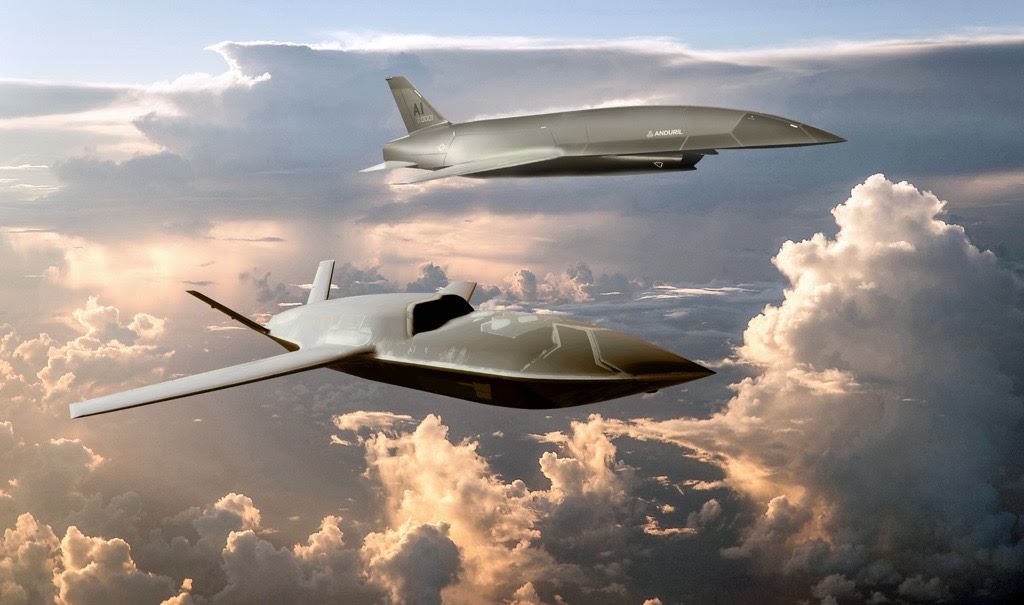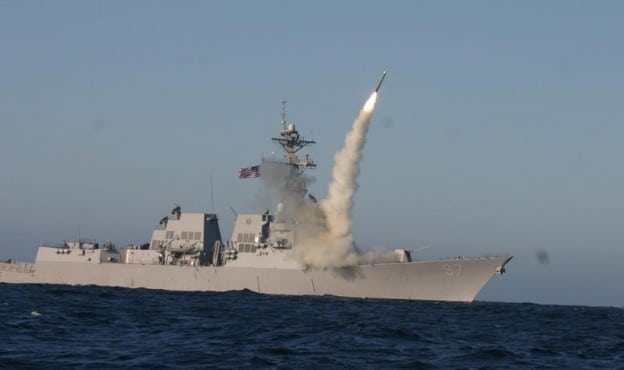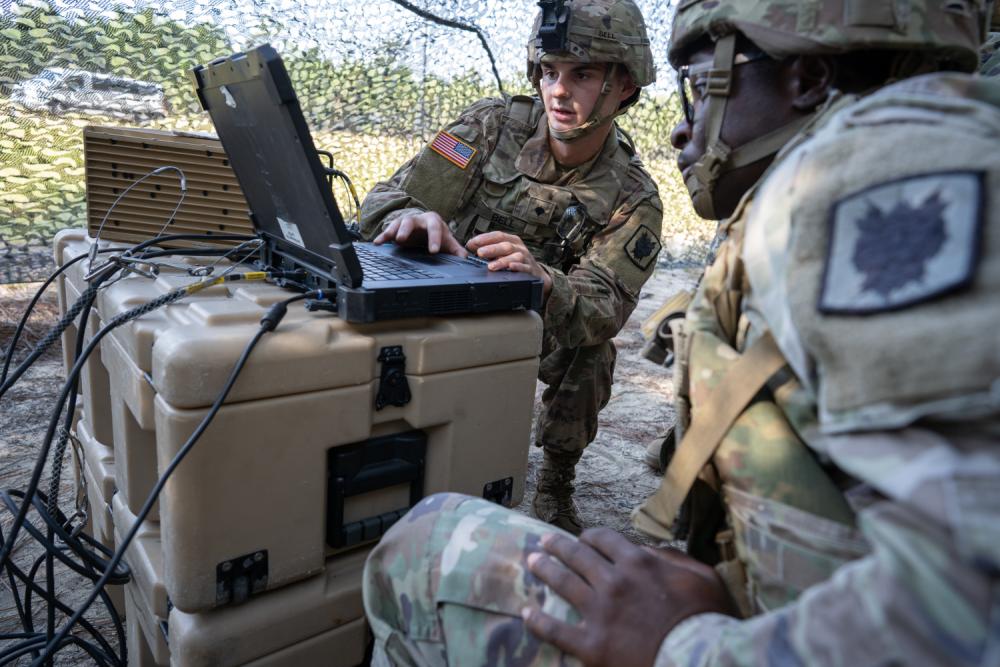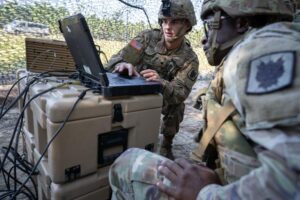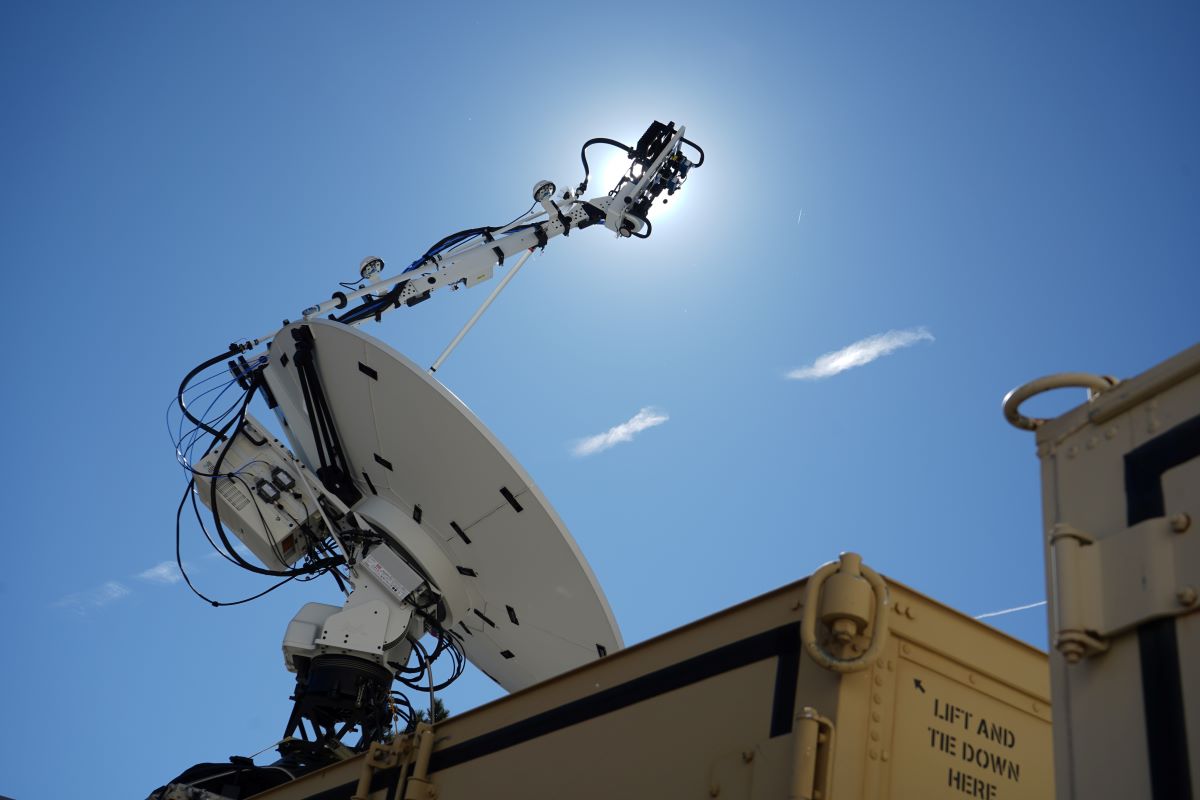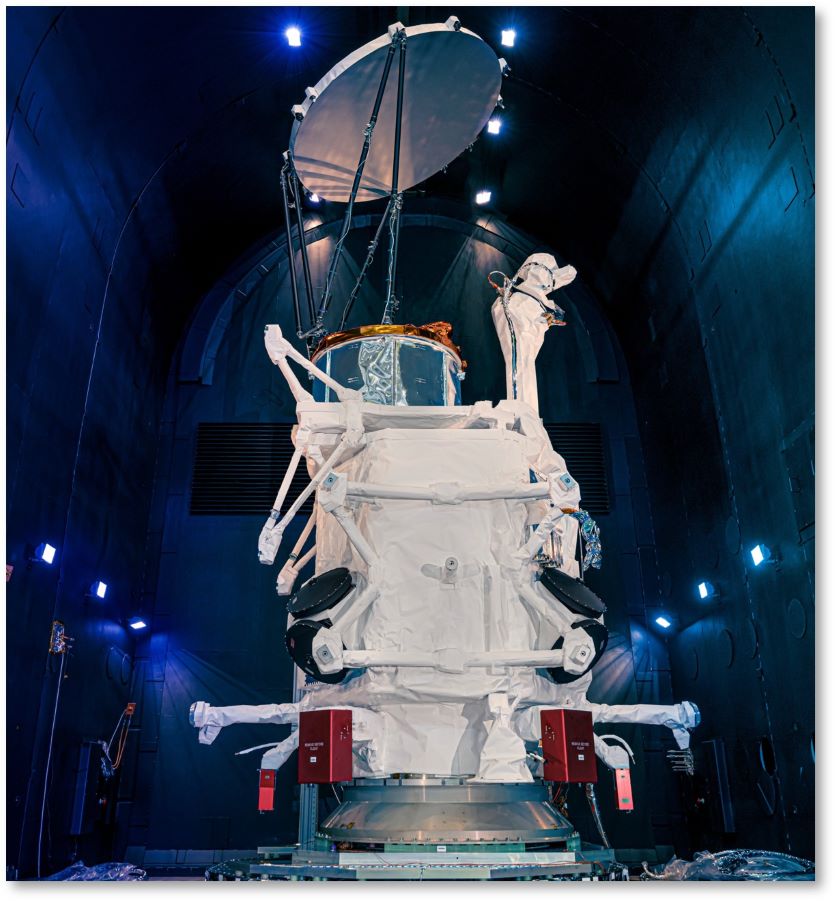GD Waiting On Sub Money. General Dynamics CEO Phebe Novakovic told financial analysts recently the company has not yet received the supplemental shipbuilding money approved by recent continuing resolutions. The company is working with the Trump administration to get the supplemental under contract and they have had “very productive conversations,” Novakovic said during the first quarter earnings call for 2025 on April 23. She also said the Navy intends to have the Block 6 Virginia-class submarine contract come this year alongside the full construction contract for the second
Columbia-class ballistic missile submarine. “So the Navy intends for those to happen this year, but I think we need a lot of building blocks before we get there, including getting the supplemental under contract and starting to execute there..”
Philippines Warehouse. The Navy issued a solicitation looking to lease a climate controlled warehouse and associated spaces if at least 20,000, but preferably about 33,000, square feet in Subic Bay, Philippines. This potential 10-year lease, without renewal options, would be the largest prepositioning facility in the country since 1992. The Navy said it would use the facility to primarily store and maintain vehicles and their equipment. This includes a motor transport shop that can house 10 medium to heavy vehicle maintenance bays. The Port of Subic Bay used to feature Naval Station Cubi Point and still receives significant American activity every spring during the annual bilateral Balikatan exercises. The Navy wants the space to be ready for occupancy by May 2026, but later occupancy will be considered. The government plans to award the lease by this August and then be executed by September, with the commencement date of the lease to be within 12 months of lease execution. Offers are due by June.
Balikatan 25. The U.S. and Philippines governments kicked off the 40th annual bilateral maritime exercise between the two countries on April 22, Exercise Balikatan 25. The Navy says this exercise supports the U.S.-Philippine Mutual Defense Treaty by ensuring forces are proficient, modernizing mutual capabilities and strengthening military-to-military coordination. In his remarks during the opening ceremony, Lt. Gen. James F. Glynn, U.S. exercise director and Commander of U.S. Marine Corps Forces Pacific, said this year’s iteration has over 14,000 participants and over 20 countries participating or observing the exercise.
Aussie NUWC Visit. Air Vice-Marshal Gerry van Leeuwen, head of Guided Weapons and Explosive Ordnance Systems for Australian Defense Ministry visited Naval Undersea Warfare Center (NUWC) Division Newport on April 7, part of an eight-day trip by hm to visit industry and defense facilities. During the trip, van Leeuwen noted NUWC Newport is a significant contributor devising development of joint and cooperative programs like the Mark 54 MoD 2 and Mark 48 heavyweight torpedoes. The Navy noted his visit was focused on the Mark 54 torpedo cooperation. John Fastino, head of the Weapons Systems Division in Division Newport’s Undersea Warfare (USW) Weapons, Vehicles, and Defensive Systems Department, said they wanted to show the Australian the capability range at Division Newport and they focused on hardware development and modeling and simulation for lightweight torpedoes. “We’re trying to get more of a partnership on the software algorithm development side, which the Royal Australian Navy and [Australian Defence Science and Technology Group] have played an important role in the past. We’re trying to continue that.”
Hyundai at HII. South Korean HD Hyundai heavy Industry leaders visited HII’s Ingalls Shipbuilding division facilities on April 22 as the two companies work to find maritime cooperation following the signing of a memorandum of understanding between the two earlier this month. HII said this visit focused on identifying near-term opportunities and exploring how to implement new processes that could support accelerating ship production.
USAF 23rd Electronic Warfare Squadron. On Apr. 18, the U.S. Air Force’s 350th Spectrum Warfare Group (SWG) at Eglin AFB, Fla., stood up its 23rd Electronic Warfare Squadron–a successor to the WWII-era 23rd Fighter Squadron and the 350th SWG’s Detachment 1. The 23rd Electronic Warfare Squadron “supports mission data file reprogramming efforts for command and control, intelligence, surveillance and reconnaissance platforms, combat rescue platforms and expendables for the Combat Air Force (CAF), including the High-Speed Anti-Radiation Missile (HARM),” the 350th SWG said. Air Force Lt. Col. Luke Marron, who headed the 350th SWG Detachment 1, commands the 23rd Electronic Warfare Squadron.
Common Tactical Edge Network. The U.S. Air Force program executive office for command, control, communications, and battle management–headed by Maj. Gen. Luke Cropsey–flight tested the Common Tactical Edge Network (CTEN) at Hanscom AFB, Mass., in April prior to the Emerald Flag 25-1 exercise, led by the 96th Test Wing at Eglin AFB, Fla. The aerial networking CTEN “is a vendor-built, open architecture, government-owned overlay network replacing the existing prototype to enable distributed battle management command and control in highly contested environments,” the Air Force said. “For Emerald Flag, a new payload was developed to re-host virtual routers and integrate CTEN software onto a single-board computer within a single-level environment, demonstrating the systems adaptability. The capability aims to provide tactical edge communications to enable dynamic distributed battle management command and control in contested and highly contested environments in support of Combined Joint All-Domain Command and Control, or CJADC2.” Among the participants in the CTEN flight testing were MITRE, the Massachusetts Institute of Technology Lincoln Laboratory, the Georgia Tech Research Institute, Sierra Nevada Corp., Boeing, L3Harris Technologies, Lockheed Martin, Northrop Grumman, and RTX, the Air Force said.
Expanding Partnership. L3Harris Technologies is teaming with Palantir Technologies to integrate artificial intelligence and resilient command and control communications “into a next generation C5ISR architecture for international customers,” L3Harris Chief Chris Kubasik said last week. The collaboration was born from an ongoing partnership between the companies, he said on the company’s first quarter earnings call. L3Harris is doing the communication systems integration for Palantir on the Army’s TITAN tactical intelligence ground station, and is integrating Palantir’s Foundry platform into its software defined tactical radio network, which is “driving new insights and advancement, bringing artificial intelligence to the battlefield by enhancing the data processing power of tactical networks,” Kubasik said.
Bear Power. Shipbuilder Austal USA is leveraging a software platform developed for shipyards by BigBear.ai for capacity planning, real estate and resource optimization, and digital twins. BigBear.ai said it will support the Alabama-based shipbuilder as part of a major facility modernization investment.
More Innovation Hubs. The Defense Innovation Unit plans to expand its OnRamp Hubs to three new states, Kentucky, Montana, and Minnesota to better engage with, and make itself more accessible to, funders, startups and other companies with commercial and dual-use technology to market and sell their capabilities to the Defense Department. DIU has OnRamp Hubs in Phoenix, Honolulu, Wichita, Kan., Dayton, Ohio, and Renton, Wash., near Seattle. The new hubs align with congressional intent.
Finnish Built Icebreakers? Finnish media in mid-April reported that the U.S. Coast Guard is in negotiations with Rauma Marine Constructions to build up to five medium icebreakers for the service. The Coast Guard on April 11 released a Request for Information to survey the domestic and global marine industrial base to build a medium polar icebreaker within three years to complement its future heavy Polar Security Cutter. The market survey is underway “pending requisite legislative authority and appropriations to acquire additional icebreakers,” the service said last week in a statement. “At this time, the Coast Guard is not involved in any negotiations with a foreign shipyard.” Rauma is located in southwest Finland on the Gulf of Bothnia.
DoD Tech for Border. The Defense Department last week said it has deployed the Ground-Based Operational Surveillance System (Expeditionary) to the Border Patrol’s San Diego Sector in support of Joint Task Force-Southern Border to help curb illegal activity along the U.S. border with Mexico. G-BOSS (E). The mobile surveillance system is equipped with mast-mounted cameras, radar, and infrared sensors to provide day and night 360-degree detection of individuals and vehicles up to eight miles away, including in challenging weather conditions. G-BOSS (E) was developed for force protection operations in Iraq and Afghanistan.
JUMP Deal. The Italian Ministry of Defense has awarded AeroVironment a five-year $46.6 million contract to provide JUMP 20 vertical takeoff and landing fixed-wing unmanned aircraft systems, including engineering services, initial sustainment, and onsite technical support. The Group 3 UAS has a 30-pound payload capacity, more than 13 hours of endurance, and a 115 mile range. The Italian MoD currently operates Shadow UAS supplied by Textron.
Drone Deal. Hydrogen-powered drone developer HevenDrones last Friday said it has acquired Zepher Flight Labs (ZFL), adding to its portfolio of unmanned aircraft systems and related capabilities. ZFL’s Z1 vertical takeoff and landing fixed-wing electric UAS is nearing qualification by the Defense Innovation Unit for inclusion on the Blue UAS list. ZFL also gives Heven one of the two portable hydrogen-generation systems funded by DIU under the Hydrogen at the Tactical Edge of Contested Logistics program. ZFL’s 20 employees are now with Heven. “Our complementary capabilities will allow us to accelerate the development of drone technologies, and together, we will continue to push the boundaries of what is possible in unmanned flight,” Adam Stolz, CEO of ZFL, said in a statement.
People News. X-Bow Systems has appointed a chief financial officer, Hector Fernandez, who most recently was chief investment officer for the boutique merchant bank Paralign Capital Partners. The Professional Services Council is getting a new CEO, Jim Carroll, who will succeed David Berteau. Berteau is departing after nine years at the Helm. Carroll, who most recently was a partner at the law firm Frost Brown Todd, was director of the Office of National Drugg Control Policy during the first Trump administration.
Breaching Robot. The Army on April 21 released a Request for Information for the new Breaching and Demolition Ground Engineer Robot (BaDGER) program, which aims to develop an autonomous breaching system “capable of neutralizing explosive hazards, minefields and improvised explosive devices.” “The BaDGER supports multi domain operations by performing a critical role in the execution of penetration, disintegration and exploitation in the close maneuver areas. The BaDGER capability will support autonomous breaching by providing detection, reduction, proofing and marking while removing soldiers from the breach. It will be reliable, tailorable, and capable of breaching complex obstacles,” the Army writes in the RFI. Industry’s responses to the RFI are expected to inform the level of interest in a potential industry day for, gauge whether there are current solutions available to meet potential BaDGER requirements and to garner feedback on draft requirements and program plans.
CBRNE Data. Persistent Systems said on April 23 it has been selected to provide its Wave Relay MANET solution as the data link to connect the Army’s Chemical, Biological, Radiological, Nuclear, and Explosives (CBRNE) sensors to operators as part of the Dismounted Reconnaissance Sets, Kits and Outfits (DRSKO) program. “Providing [the Army] with advanced networking capabilities ensures seamless integration between CBRNE sensors and command posts, and operators for the real-time transfer of critical data beyond just voice,” Damien Mason, Persistent Systems’ director of Army strategy, said in a statement. “This program represents a significant modernization effort for the Army’s CBRNE community, enabling faster and safer threat detection.” Persistent Systems said its Wave Relay MANET capability will allow soldiers to receive “instant notifications” on CBRNE threats directly to their Android Tactical Assault Kit devices.
Ireland FMS. The State Department on April 23 approved a potential $46 million foreign military sale with Ireland for Javelin missiles and lightweight command launch units. The new FMS case specifically covers 36 launch units that will be added to a previously implemental case for 44 of the Lockheed Martin and RTX-built Javelin missiles, which was valued at $8.7 million and fell below the congressional notification threshold. The deal also includes missile containers, U.S. government technical assistance, training equipment and logistics support. “The proposed sale will enhance Ireland’s capability to build its long-term defense capacity to defend its sovereignty and territorial integrity to meet its national defense requirements,” the Defense Security Cooperation Agency said in a statement.
MicroLED Study. The Army has awarded Kopin a contract to conduct a soldier display trade study to help define optimal MicroLED characteristics for Extended Reality (XR) heads-up displays (HUDs), the company said on April 24. “The Soldier Display Trade Study focuses on identifying ultrabright MicroLED tradeoffs to optimize see-through XR applications, prioritizing daytime-readable displays that are brighter, more energy-efficient, and capable of delivering clear visibility across diverse lighting conditions-from intense daylight to overcast starlight,” Kopin said. The trade study will culminate in a “Microdisplay Requirements and Performance Matrix,” according to Kopin, adding that MicroLED technology offers “distinct advantages over traditional solutions including superior brightness, enhanced power efficiency, and long operating lifetimes and eliminates the temporal artifacts associated with Laser Based Scanning.”
S-92 Support. Sikorsky said on April 24 it has signed a long-term agreement with Bristow Group to continue support for its fleet of more than 60 S-92 helicopters, which the group operates for offshore energy and search and rescue operations. “Bristow is the largest operator of the S-92 globally,” Stu Stavley, Bristow’s chief operating officer for offshore energy services, said in a statement. “This long-term support agreement will enable us to maintain our high level of service to our customers, while also controlling our operational costs and improving our overall efficiency.” The new agreement, which extends the two firms’ partnership into the 2030s, provides coverage for over 90 percent of replacement costs for aircraft parts and “enhanced global fleet support with access to Sikorsky’s worldwide network of forward stocking locations and field service representatives,” according to Sikorsky.
Satellite Processing Award. Space Systems Command last Friday said it awarded Lockheed Martin’s Astrotech Space Operations a $77.5 million contract to expand commercial space vehicle processing capacity for National Security Space Launch missions at Vandenberg Space Force Base, Calif., by 2028. The award was made under the NSSL Space Vehicle Processing Commercial Solutions Opening. The “award is a public-private partnership for cost sharing of much needed launch infrastructure to support the increased demand of both military and commercial launch activities,” Col. Dan Highlander, director of operations integration for the command’s Assured Access to Space Program Executive Office, said in a statement. He added that Astrotech will improve the Space Force’s “responsive and resilient launch capabilities for the warfighter.” Four offers were received for the work.
